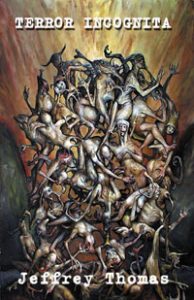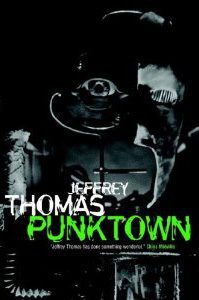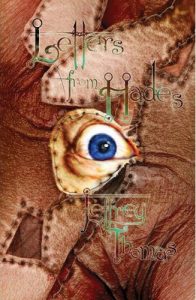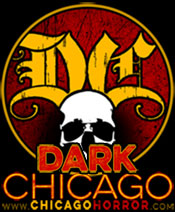 LAST WEEK, one of my favorite authors, Jeffrey Thomas, interviewed me for his blog (you can read my responses to his interview here if you’re so inclined). It occurred to me while answering his questions that, having read a lot of Jeff’s work over the years — and even publishing some of it (in Dark Arts Books’ anthology Waiting For October) — I had a few questions of my own to throw right back at him! And so… here is my interview with Jeffrey Thomas!
LAST WEEK, one of my favorite authors, Jeffrey Thomas, interviewed me for his blog (you can read my responses to his interview here if you’re so inclined). It occurred to me while answering his questions that, having read a lot of Jeff’s work over the years — and even publishing some of it (in Dark Arts Books’ anthology Waiting For October) — I had a few questions of my own to throw right back at him! And so… here is my interview with Jeffrey Thomas!
Jeff has been publishing dark fiction for more than 20 years, and is probably best known for his Punktown series of novels and short story collections. He’s been published in the venerable Year’s Best Fantasy & Horror anthologies, and his work has been translated in German, Russian and Greek. He’s also the author of one of my favorite novels of the past decade, Letters from Hades. Here are his answers to the questions I threw at him:
1) Jeff, does it worry you that when someone types in www.jeffreythomas.com they arrive at an obituary for a scholarly bookseller? You’re still on this side of the Inferno, right?
JET: As far as I know, though one of these days I could have one of those Carnival of Souls moments and realize I was actually killed in a plane crash coming home from my recent vacation to Vietnam, and that I’m not sitting home because I’m laid off and unemployed – I’m dead! But it’s OK I’m dead so long as Massachusetts keeps the checks coming. But yeah, I wish I could have gotten that URL. My friend Nick Curtis, who runs my web site/blog for me, was able to get me www.JeffreyEthomas.com instead, my middle initial being E. (The reason I sign my artwork JET.) JeffreyEThomas.com is not ideal, since not everyone’s going to think to put the E in there, but…maybe if that other poor guy is dead, we’ll get his URL one of these days.
2) I’m proud to say I own signed copy #8 of your first hardcover short fiction collection, Terror Incognita, which came out shortly before my own first collection with Delirium Books. Terror Incognita includes two of my favorite short pieces of yours, “John Sadness” and “Disfigured.” How did you go from publishing in a variety of small press magazines and via your own press to getting your first hardcover book deal… and what did that first book mean to you?
 JET: Oh, I was over the moon about Terror Incognita – it was the long, long-awaited realization of my dreams, dreams going back to my youth. I dedicated the book to my late father, who passed away shortly before the book came out (in 2000). He was a locally published poet, so he was very proud that my brother Scott and I had been getting stories published in the indie press. It was also very rewarding that after years of submitting book proposals to publishers, and being turned down, Delirium Books came to me with the idea of doing a book. Ahem! That fact alone represented just how diligently I’d worked to make some kind of name for myself in the small press, since the late 80s. It was when I knew I had paid my dues. Anyway, I’m glad you like the collection, John, and “John Sadness” is one of my favorites of my own stories, too. It was inspired by my feelings upon having been told for the first time that my son Colin is autistic.
JET: Oh, I was over the moon about Terror Incognita – it was the long, long-awaited realization of my dreams, dreams going back to my youth. I dedicated the book to my late father, who passed away shortly before the book came out (in 2000). He was a locally published poet, so he was very proud that my brother Scott and I had been getting stories published in the indie press. It was also very rewarding that after years of submitting book proposals to publishers, and being turned down, Delirium Books came to me with the idea of doing a book. Ahem! That fact alone represented just how diligently I’d worked to make some kind of name for myself in the small press, since the late 80s. It was when I knew I had paid my dues. Anyway, I’m glad you like the collection, John, and “John Sadness” is one of my favorites of my own stories, too. It was inspired by my feelings upon having been told for the first time that my son Colin is autistic.
3) We “grew up” in the genre at roughly the same time. I saw your name in a lot of the same magazines I was publishing (or trying to publish) in during the ’90s. How do you feel about the landscape of magazines and short fiction now, compared to when you were first starting out? I have my own nostalgic view of the ’90s zine scene, but I wonder how you feel things have changed and whether it’s for good or ill.
JET: Yeah, John – recently when I interviewed you for my blog, and reviewed your own history, I saw a lot of parallels between us. Appearances in small press zines, then on to Delirium Books, starting our own indie press imprints, eventually breaking into mass market, all around the same time. The zine scene seems a lot different now, but then I’m not really sure what zines might be out there – I don’t follow that like I once did, so avidly.
It seems to me that because of the cost of conventional printing, zines have been largely replaced by web zines and books produced by POD (print-on-demand) technology. It’s not a bad thing – POD has helped many small publishers bring out mighty fine-looking books, much nicer than my own little 90s zine The End, which I pasted up by hand on a light table! – but it’s a different feeling, and I do miss those days. I was so excited back then just to get a story into some little saddle-stabled booklet with photocopied pages. More excited than I am sometimes, now, to get a story in some slick-looking anthology!
I found out only a day or two ago that Janet Fox, who published The Scavenger’s Newsletter, had passed away, and that was very sad news. Scav was an invaluable resource to me back in those days, and I remember it and Janet fondly. I have to credit her a lot, in terms of whatever success I achieved in the small press – and hence, beyond. Yeah, it all comes back to me now. I remember the days when Cemetery Dance was a dot matrix publication. And I still couldn’t get published in it! But a few years ago they wrote and asked me if I could give them a story. Ahh…again, the fruits of one’s labor!
4) I was sad to hear about Janet too — I still have a box of Scavenger’s Newsletters that I simply can’t part with. They totally represent that era for me.
While your early short work explored a wide range of conceits, over the past decade it seems that you’ve focused more and more on developing your Punktown world, both in short fiction and novels. What was the inspiration for Punktown, and what draws you to write in “that world” so often?
 JET: Back as early as 1980 I consciously set out to create a future world – not so much a prediction of the future, though, as a kind of Otherwhere – where I could mix genres and satirize or comment on society and the human condition. It being the time of punk rock, I called it Punktown. My early Punktown stories, mostly handwritten novels, just filled up my desk drawers, though, until I started selling Punktown short stories to the small press in the 80s and 90s. Finally in 2000, The Ministry of Whimsy Press put out the collection Punktown and the reception was very kind indeed. That inspired me to write more Punktown stories – but mostly, it’s just such a fun place to write about. I can do anything there.
JET: Back as early as 1980 I consciously set out to create a future world – not so much a prediction of the future, though, as a kind of Otherwhere – where I could mix genres and satirize or comment on society and the human condition. It being the time of punk rock, I called it Punktown. My early Punktown stories, mostly handwritten novels, just filled up my desk drawers, though, until I started selling Punktown short stories to the small press in the 80s and 90s. Finally in 2000, The Ministry of Whimsy Press put out the collection Punktown and the reception was very kind indeed. That inspired me to write more Punktown stories – but mostly, it’s just such a fun place to write about. I can do anything there.
You want to do horror? You want to do detective fiction? Want to throw in a mutant, a robot, some Lovecraftian stuff?
It’s a place that supports all kinds of plot-lines. I feel more comfortable there because I can make the rules. Today I started to work on a new story in which I wanted the protagonist to be a pharmacist. But then I wondered how young could a pharmacist be? What would the person have to study to be a pharmacist, how long would it take, and so on. All these banal things you’d have to research. Not that I dislike research, but I get insecure about getting even the smallest thing wrong. I’m kind of a wallflower type of guy, I have to say. The real world and I have a wary sense of each other. Punktown…that’s my home.
5) Punktown moved from a collection of short connected fiction (Punktown) to a novel (Monstrocity) to another collection (Shades of Grey) to two mass market novels Deadstock and Blue War. What is the next entry in the Punktown world?
JET: Well, first off I’ve also had the novels Everybody Scream! and Health Agent come out, too, and these were in fact two of the handwritten trunk stories I wrote in the 80s. I type with one finger and I’m fast, but retyping is too tedious, so I had these novels typed up for me (one by the publisher, one by my sister-in-law) and both were published by Raw Dog Screaming Press. I’m as proud of them, overall, as I am my more recent Punktown work. There’s also been a third collection of Punktown short stories, the recent Voices From Punktown from Dark Regions Press. I’ve pitched several ideas for a third Jeremy Stake novel (Stake is the private eye protagonist of both Deadstock and Blue War), and I’m crossing my fingers that one of them will get the green light so I can keep Punktown out there in the mass market.
6) Your Letters From Hades is one of my favorite novels of the past decade and stands next to Edward Lee’s Infernal novels as a wonderfully inventive look at hell. How did that novel come about, and what offshoots has it engendered?
 JET: I’m pleased you like it that much; it’s been rewarding to hear that it’s a favorite with a bunch of people. I have to credit David G. Barnett of Necro Publications with its creation. Dave loved a short story of mine called “Coffee Break,” and asked if I could set an entire novel based on a vision of Hell like that. How could I turn down such a challenge? I’ve since written a number of short stories set in the Hell of Letters From Hades, these being collected in my book Voices From Hades from Dark Regions. I also wrote a loose sequel to Letters From Hades, Beautiful Hell, which along with a novella from Carlton Mellick III became the book Ugly Heaven/Beautiful Hell, from Delirium.
JET: I’m pleased you like it that much; it’s been rewarding to hear that it’s a favorite with a bunch of people. I have to credit David G. Barnett of Necro Publications with its creation. Dave loved a short story of mine called “Coffee Break,” and asked if I could set an entire novel based on a vision of Hell like that. How could I turn down such a challenge? I’ve since written a number of short stories set in the Hell of Letters From Hades, these being collected in my book Voices From Hades from Dark Regions. I also wrote a loose sequel to Letters From Hades, Beautiful Hell, which along with a novella from Carlton Mellick III became the book Ugly Heaven/Beautiful Hell, from Delirium.
In the very near future, Dark Regions will be bringing out my novel The Fall of Hades, again a loose sequel to Letters From Hades and Beautiful Hell, which takes place two thousand years in the future after the destruction of the Earth – and of Hades, too. It’s a bizarre mix of horror, science fiction, fantasy and the kitchen sink (yes, there’s even a chapter called The Kitchen Sink), that I believe is one of the very best things I’ve written. I hope it gets the attention I so humbly believe it deserves. And by the way, one needn’t have read Letters From Hades or Beautiful Hell to enjoy The Fall of Hades; like all my Punktown stories are meant to do, as well, it stands on its own.
7) Your brother Scott is a noted dark fiction writer in his own right and you’ve collaborated with him on several projects. How is it that you both ended up working in the dark fiction arena, and what drove you to collaborate rather than duke it out competitively (as brothers so often do!)?
JET: Oh, we’ve been more competitive than collaborative – our collaborations have been relatively few, these being a single short story, the book Punktown: Shades of Grey (we each wrote half the stories in that collection), and the paired individual novellas that comprise the yet-to-be-published The Sea of Flesh and Ash – but it’s been a friendly and encouraging kind of competition that has actually forced us to both evolve and hone our creative efforts. We grew up in a family that loved to read and was very artistic, but what drove Scott and I to the dark side I couldn’t say. I plug Scott any chance I get, because his stuff is awesome. I urge people to look up his collections The Garden of Ghosts, Over the Darkening Fields and Midnight in New England. His specialty is Victorian-type supernatural stories, set in England or New England.
8) I remember seeing the logo for Necropolitan Press in magazines back when I first started publishing short fiction. I loved the name, the logo, and the fact that someone could have their own small horror press. In that way, I’m sure it helped me to found my own Dark Arts Books imprint more than a decade later (and where I was psyched to be able to publish new Jeffrey Thomas fiction in our second release, Waiting for October!). How did Necropolitan come about, and why did you decide to revive it recently after several years of hiatus?
JET: It was so fun being published in those zines we’ve already discussed that it seemed natural I’d want to create my own, especially where I already worked in a printing company as a paste-up artist. Just another outlet for my creative urges. I started with four issues of The End magazine, then went on to publish chapbooks by such brilliant writers as Jeff VanderMeer and W. H. Pugmire. But it started to consume too much of my writing time – and too much money! – putting the projects together, reading for them and getting them out there, so I had to stop. It was Nick Curtis, an admirer of my work, who inspired me to revive Necropolitan Press, this time with him as my partner. It’s Nick who does all the real work now – I pretty much just picked our first project, Paul (The Little Sleep) Tremblay’s disturbing novella, The Harlequin and the Train. We don’t have a second project planned yet, but we’ll see what the future holds. Our site is: www.necropolitan-press.com.
 9) In addition to being a writer and publisher, you’re also an artist. I know my own path into working on book cover art was somewhat accidental… how did you get into book cover design?
9) In addition to being a writer and publisher, you’re also an artist. I know my own path into working on book cover art was somewhat accidental… how did you get into book cover design?
JET: I was an artist before I started to write, really, and so my two interests developed simultaneously, though my love of writing came to greatly overpower my love of creating art. (I’m a decent artist, but my hands can’t keep up with the visions in my mind.) I’ve done a bunch of zine illustrations, and covers for some of my own chapbooks and books, like the original edition of my collection Aaaiiieee!!! and the cover of Health Agent. My cover for my collection Thirteen Specimens is a photo, though, of various weird items I had around the house.
10) Writers are inspired by a lot of things, and often by other writers/artists/musicians. Who are some of the creative inspirations that drive you to dream?
JET: Too many to name, but stand-outs would be writers as diverse as H. P. Lovecraft, Thomas Hardy, Yukio Mishima, Clive Barker, Chuck Palahniuk and Martin Cruz Smith…artists like H. R. Giger (who supplied cover and interior art for the German hardcover edition of Punktown – talk about a wildest dream come true!)…musicians like Elvis Costello and Nick Cave. Even video games, like the Silent Hills and the Zeldas, and favorite movies like Taxi Driver, Eraserhead, Blue Velvet, Fight Club, The Exorcist, The Godfather, Planet of the Apes (original!!), and on and on. Such creative works might not directly inspire, but they keep you excited about the creative process in general.
11) What are you working on now and/or, what should we be looking for from Jeffrey Thomas in 2010? I’ve still got a couple open spots on my bookcase!
JET: I definitely want to push my previously mentioned novel The Fall of Hades, due out in hardcover in the next month or so. Dark Regions will also be bringing out another collection of mine, called Nocturnal Emissions, which consists of reprints and new material – such as a story called “Waltered States” which, with his blessing, stars pop singer Walter Egan (Magnet and Steel) as its protagonist, as he comes into conflict with a weird singing duo from another dimension. Aside from that and some other projects further back in the pipeline, I just got the go ahead from a cool small press publisher I’ve worked with before for a brand new novel. But I don’t want to discuss it more, until contracts are inked and I get a better handle on what the damn thing is going to be about! In theory, being unemployed should give me more time in which to write…though it hasn’t seemed that way yet!






